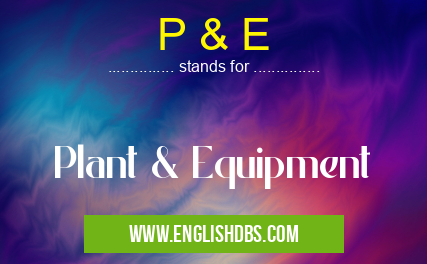What does P & E mean in BUSINESS
P & E (Plant & Equipment), is an accounting term used to describe the tangible assets of a business that are used in its operations. These assets are typically long-term in nature and include items such as machinery, buildings, vehicles, and furniture.

P & E meaning in Business in Business
P & E mostly used in an acronym Business in Category Business that means Plant & Equipment
Shorthand: P & E,
Full Form: Plant & Equipment
For more information of "Plant & Equipment", see the section below.
Understanding P & E
P & E assets are classified as fixed assets on a company's balance sheet and are depreciated over their useful life. Depreciation is a non-cash expense that reduces the value of the asset over time, reflecting its declining value due to wear and tear or obsolescence.
The value of P & E assets can fluctuate over time, depending on factors such as changes in technology, market conditions, and maintenance costs. Companies must regularly monitor the condition and value of their P & E assets to ensure they are being utilized efficiently and effectively.
Importance of P & E
P & E assets are crucial for the operations of a business, as they provide the necessary infrastructure and resources for production and service delivery. Adequate P & E can enhance efficiency, productivity, and profitability.
Essential Questions and Answers on Plant & Equipment in "BUSINESS»BUSINESS"
What is P&E (Plant & Equipment)?
P&E (Plant & Equipment) refers to the physical assets that a business owns and uses in its operations. These assets include machinery, buildings, vehicles, and other fixed assets used in the production or delivery of goods and services.
What is the importance of P&E for a business?
P&E is crucial for businesses as it enables them to perform their operations efficiently. Adequate P&E ensures smooth production processes, efficient transportation of goods, and comfortable working environments for employees. It also contributes to the overall productivity and profitability of the business.
How are P&E assets classified?
P&E assets are typically classified into various categories based on their functionality and usage. Common classifications include:
- Land and Buildings: Property and structures owned by the business.
- Machinery and Equipment: Tools, machines, and equipment used in production.
- Transportation Equipment: Vehicles used for transporting goods or personnel.
- Furniture and Fixtures: Equipment and furnishings used in offices and work areas.
- Other P&E: Assets that do not fit into other categories, such as technology infrastructure or research and development equipment.
How is P&E accounted for in financial statements?
P&E assets are typically capitalized and recorded on the balance sheet as non-current assets. They are depreciated over their useful life to reflect their gradual consumption and loss of value. The depreciation expense is charged against income, reducing the asset's book value and matching its cost to its period of use.
What are the key factors to consider when managing P&E?
Effective P&E management involves careful planning, maintenance, and replacement strategies. Key factors to consider include:
- Asset utilization: Optimizing the usage of P&E to maximize productivity.
- Maintenance: Regularly monitoring and maintaining assets to prevent failures and extend their lifespan.
- Replacement planning: Determining the optimal time to replace aging or inefficient assets to minimize downtime and maintain production efficiency.
- Cost management: Balancing the costs of acquisition, maintenance, and replacement to achieve long-term profitability.
Final Words: P & E are essential assets for many businesses, representing their physical presence and operational capabilities. Proper management and maintenance of P & E assets are vital for long-term success and competitiveness. By understanding the role and importance of P & E, businesses can make informed decisions about investing in and utilizing these assets to maximize their value and contribute to overall growth.
